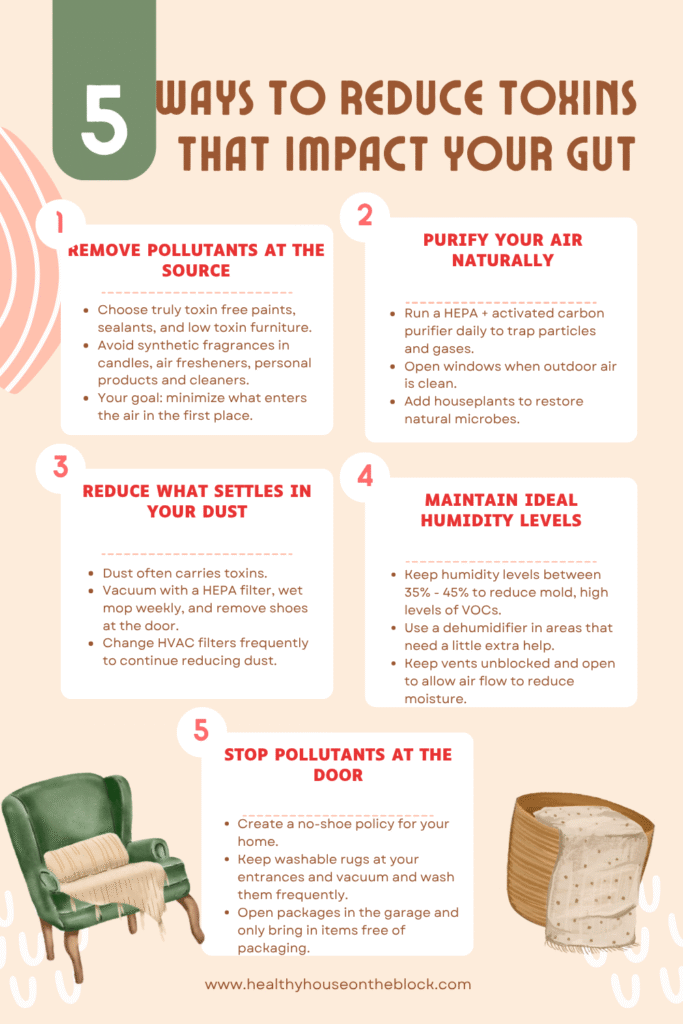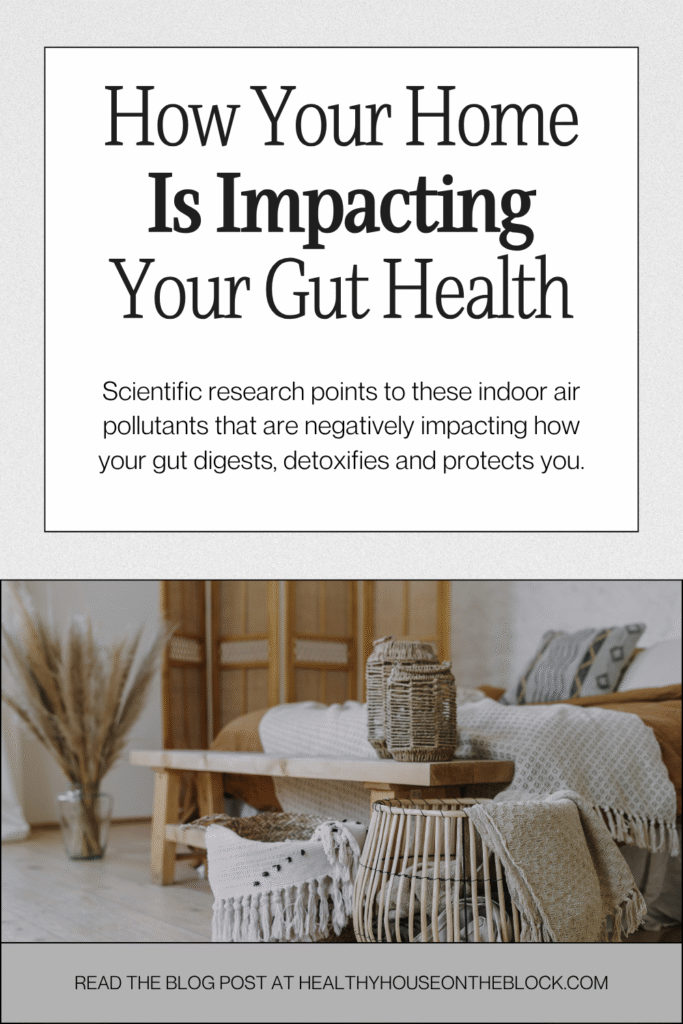
When most people hear “indoor air quality,” their minds immediately go to their lungs — allergies, asthma, maybe a stuffy nose or dry throat. But scientists are now uncovering something much bigger: the air inside your home may also shape your gut health.
A recent study from the Harvard T.H. Chan School of Public Health found that indoor air pollution can alter the gut microbiome, the intricate community of microorganisms that lives inside your digestive tract and supports everything from immune strength to mental clarity. This finding is part of a growing body of research connecting environmental toxins to the internal balance of bacteria, fungi, and other microbes that keep your body running smoothly.
In other words, what’s floating in the air around you could be quietly influencing how well your gut digests, detoxifies, and protects you.
The Air–Gut Connection: What’s Happening Inside
Your gut microbiome acts like an internal ecosystem — a rainforest of bacteria that communicate with nearly every system in your body. It helps metabolize nutrients, regulate hormones, and even produce neurotransmitters like serotonin. When this balance is disrupted, inflammation takes over, immunity weakens, and the entire body feels the ripple effects.
Most of us already understand how diet, antibiotics, and stress can shift the microbiome. But now we know the air we breathe plays a role too. The Harvard research found that exposure to particulate matter (PM2.5) and volatile organic compounds (VOCs) — common pollutants in indoor air — can change the gut’s microbial composition. These pollutants don’t just irritate the respiratory system; they enter the bloodstream and interact with the immune system, triggering systemic inflammation that communicates directly with the gut.
This “cross-talk” between the lungs and the gut is well documented. Scientists refer to it as the gut–lung axis, a two-way communication channel that links the immune responses of both systems. When the lungs are under stress from inhaled pollutants, the gut’s microbial community responds as part of the body’s coordinated defense. Over time, this can reduce beneficial bacteria, increase inflammatory microbes, and compromise the gut barrier.
According to research published in the National Institutes of Health (NIH) database, this chain reaction can influence conditions ranging from irritable bowel syndrome (IBS) to metabolic disorders. Simply put: when your air isn’t clean, your gut feels it.

Why Indoor Air Matters More Than You Think
Here’s the tricky part — indoor air is often far more polluted than outdoor air. According to the EPA, indoor air levels of pollutants can be two to five times higher than those found outdoors, largely because the same contaminants accumulate in enclosed spaces with limited ventilation.
And while we can’t control the air outside, we can transform the air inside our homes — and in doing so, protect our internal health in profound ways.
Indoor air pollutants come from countless everyday sources: off-gassing from furniture and flooring, cooking emissions from gas stoves, synthetic fragrances in cleaning products, and moisture issues that lead to mold. Even microscopic dust particles can carry heavy metals and pesticide residues, creating a constant source of invisible exposure.
If you’ve ever felt unusually tired, experienced brain fog, or had digestive discomfort after being at home for long stretches, these subtle pollutants might be part of the reason why. The symptoms can be vague but persistent — inflammation, low energy, and immune changes — all signs of an overwhelmed system.

How to Improve Indoor Air Quality (and Support Your Gut Health)
Let’s go beyond the basics of “open windows and get an air purifier.” The goal is to create a living space that actively supports your body’s detoxification and balance. Here’s how to get there — with strategies that reach the root of the problem instead of covering it up.
1. Purify Your Air with Purpose
A well-chosen air purifier can be one of the most powerful investments you make for your health — but not all purifiers are equal. Look for a True HEPA filter that captures ultrafine particles (PM2.5 and smaller) and an activated carbon filter to adsorb gases and VOCs. These two together remove the contaminants most linked to inflammation and gut microbiome disruption.
Avoid purifiers that rely only on ionization or ozone generation — these can actually produce secondary pollutants that irritate your lungs and stress the body further. Brands like Austin Air, AirDoctor, and IQAir are backed by third-party testing and effective for whole-room filtration.
To make the biggest difference, place your purifier where you spend the most time — the bedroom and living area — and run it continuously on low or medium. Your gut will thank you.

2. Neutralize VOCs Before They Reach You
VOCs (volatile organic compounds) are emitted from many building materials, paints, and sealants — and they’re among the worst offenders for air-related health effects. These gases can linger for years after installation, slowly diffusing into your home’s air.
One of the simplest but most overlooked steps is sealing VOC-emitting surfaces. For example, applying AFM Safecoat Safe Seal to plywood or particleboard furniture locks in off-gassing. Using ECOS Air Purifying Paint can also trap airborne toxins, converting them into harmless compounds.
Even small updates like sealing the undersides of cabinets or painting with non-toxic finishes can significantly reduce your exposure load. The key is to control the source before filtration is even needed.
3. Encourage a Healthy Indoor Microbiome
This one surprises most people — the healthiest homes actually have diverse microbial communities, not sterile environments. Our indoor microbiome mirrors our own, and exposure to beneficial bacteria in our homes may help maintain a resilient gut microbiome.
Houseplants can help with this balance. Studies have shown that certain species, such as peace lilies, pothos, and spider plants, can reduce VOC concentrations while subtly enriching the indoor microbial mix. But even more effective is controlled outdoor air exchange — briefly opening windows during clean air days allows natural microbes to repopulate indoor air.
Another often-overlooked factor? Avoiding over-sanitization. Many modern cleaners and disinfectants destroy both harmful and beneficial microbes, leaving behind a microbiologically “flat” environment that may impact your body’s microbial diversity.

4. Maintain Ideal Humidity and Ventilation
Indoor humidity levels influence far more than comfort — they also affect air chemistry and microbial growth. When humidity rises above 55%, mold spores and dust mites thrive, releasing inflammatory particles and mycotoxins. When it drops below 35%, the air becomes too dry, irritating the respiratory system and allowing dust and VOCs to remain airborne longer.
The sweet spot is between 40–50%, where both air and body stay balanced. Use a digital hygrometer to track humidity and a dehumidifier or humidifier to adjust as needed. Bathrooms, kitchens, and basements especially benefit from added ventilation. Installing a heat recovery ventilator (HRV) or energy recovery ventilator (ERV) can bring in filtered outdoor air year-round — a major upgrade for those in newer, tightly sealed homes.

5. Detox Your Cleaning and Laundry Routine
Your cleaning products might be one of your home’s most consistent sources of airborne toxins. Synthetic fragrances, chlorine bleach, and quaternary ammonium compounds (“quats”) are known to release reactive gases and reduce beneficial microbes, both in the air and on your skin.
Switching to botanical or vinegar-based cleaners is a powerful step, but also consider how you clean. Microfiber cloths that attract dust electrostatically can capture pollutants without spreading them around. A HEPA vacuum helps remove fine particles before they settle back into air currents.
Even laundry products make a difference. Opt for fragrance-free detergents and skip fabric softeners altogether — their VOC output can be significant, especially in small laundry rooms.
6. Reduce What Enters Through the Door
Your shoes are one of the biggest carriers of toxins in your home. Pesticide residues, lead dust, and bacteria hitch a ride on shoe soles and become part of your household dust, which you then breathe every single day.
Creating a shoe-free policy indoors is a simple but powerful intervention. Keep washable rugs at all entrances, provide indoor slippers or socks, and vacuum entryways often. You’ll dramatically reduce your home’s exposure to outdoor contaminants — and lower the overall load on your immune system and gut.
The Deeper Health Connection
Each of these changes might seem small, but together they reduce your daily exposure burden. When you breathe cleaner air, your body can redirect energy away from constant detoxification and toward healing and balance.
A stable gut microbiome supports your immune system, moderates inflammation, and improves nutrient absorption — all of which influence your body’s resilience to toxins. Over time, this shows up as clearer thinking, steadier energy, and a stronger sense of well-being.
This is why I always tell my clients that a healthy home is one of the most foundational forms of self-care. You’re not just changing your environment; you’re changing the way your body functions inside it.
Go Deeper with Personalized Guidance
If you’re ready to take this further and want help identifying the hidden air quality issues in your home, I offer one-on-one consultations designed to uncover your home’s biggest health stressors and create a clear, step-by-step plan to reduce them.
As a certified Building Biology Practitioner and Healthy Home Expert, I’ll help you interpret what your space is telling you — from hidden VOC sources to moisture patterns and filtration needs — and show you exactly how to transform your home into an environment that supports gut and immune health.
You can schedule your consultation here: Schedule a Consultation.
Learn More
If you found this topic eye-opening, you might also enjoy:
External Research & Resources
- Harvard T.H. Chan School of Public Health – Indoor Air Quality and Gut Microbiota Study
- EPA – Introduction to Indoor Air Quality
- NIH – Environmental Pollutants and the Gut Microbiome
- Building Biology Institute – Healthier Indoor Environments
Share this:
- Click to share on Facebook (Opens in new window) Facebook
- Click to share on LinkedIn (Opens in new window) LinkedIn
- Click to share on Reddit (Opens in new window) Reddit
- Click to share on Pinterest (Opens in new window) Pinterest
- Click to print (Opens in new window) Print
- Click to share on X (Opens in new window) X








